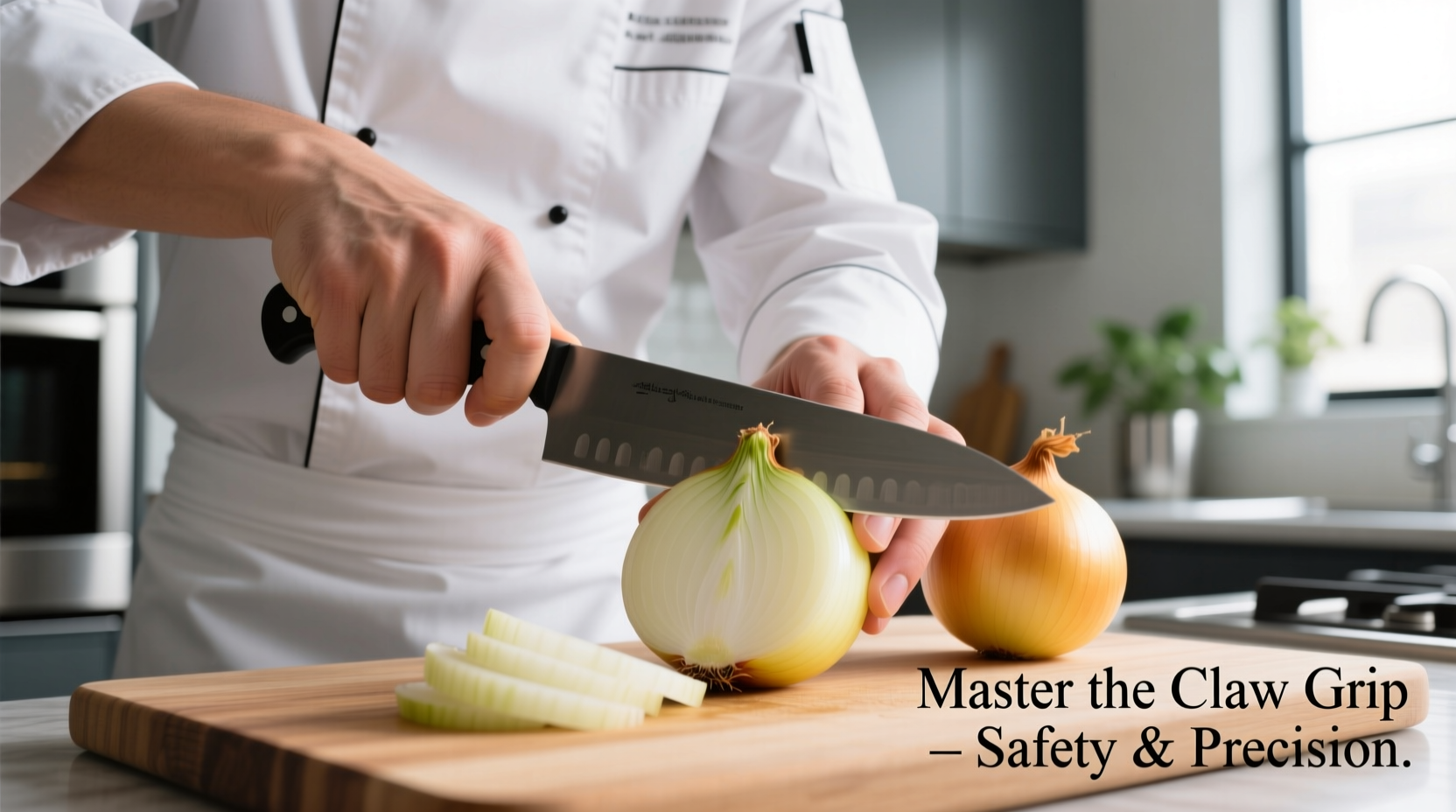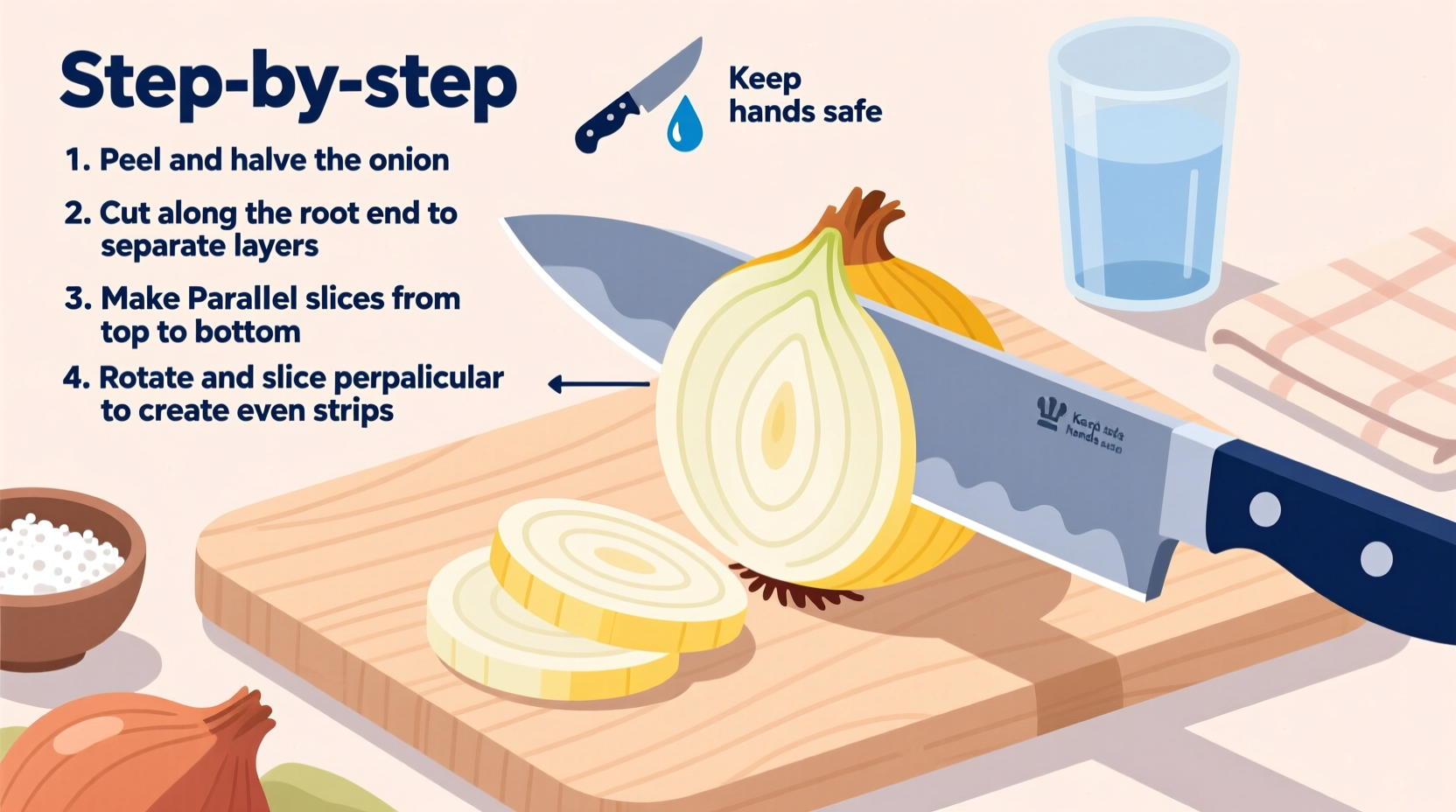Learning how to properly slice an onion transforms your cooking experience. Proper technique ensures consistent results for even cooking, reduces eye irritation, and maximizes the onion's flavor potential in your dishes. Whether you're preparing a French onion soup or a fresh salsa, the right slicing method makes all the difference.
Essential Tools for Perfect Onion Slicing
Before you begin slicing, gather these kitchen essentials. The right equipment significantly impacts your success when learning how to properly slice an onion.
| Tool | Recommended Type | Why It Matters |
|---|---|---|
| Knife | 8-10 inch chef's knife | Provides proper balance and control for precise slicing motions |
| Cutting Board | Stable wooden or plastic board | Prevents slipping and protects knife edge |
| Prep Container | Bowl of cold water | Helps reduce volatile compounds that cause tearing |
According to the Culinary Institute of America's knife skills curriculum, a sharp chef's knife is non-negotiable for safe and effective onion preparation. Dull knives require more pressure, increasing the risk of slips and uneven cuts.
Step-by-Step Onion Slicing Technique
Preparation: Setting Up for Success
Proper preparation prevents common mistakes that lead to tears and uneven slices. This foundational step in how to properly slice an onion often gets overlooked by home cooks.
- Chill onions in the refrigerator for 30 minutes before cutting (reduces volatile compounds)
- Use a sharp knife - sharpened within the last 5-7 uses
- Work near a running fan or under a vent to disperse irritants
- Cut near running water to help capture sulfur compounds

The Professional Slicing Method
Follow these precise steps for restaurant-quality results every time you slice an onion:
- Remove both ends of the onion and peel away the outer skin
- Stand the onion on its root end (this keeps layers intact)
- Make a vertical cut through the center, from root to stem
- Lay each half flat-side down on your cutting board
- Make horizontal cuts toward the root end (don't cut all the way through)
- Make vertical slices at your desired thickness
- Finally, slice across to create perfect dice or continue for thin slices
This technique, documented in the FDA's Food Code guidelines for proper food preparation, minimizes cell damage that releases tear-inducing compounds while ensuring uniform pieces for even cooking.
Advanced Slicing Variations for Different Dishes
Understanding when to use different slicing techniques represents the professional approach to how to properly slice an onion for specific culinary applications.
Context Boundaries: Matching Technique to Dish
Not all recipes require the same onion preparation. The appropriate slicing method depends entirely on your intended dish:
- Thin slices (1/8 inch): Ideal for French onion soup or caramelizing - creates maximum surface area for browning
- Medium dice (1/4 inch): Perfect for salsas and stir-fries where even cooking is essential
- Julienne (matchstick): Best for garnishes and salads where visual presentation matters
- Rough chop: Suitable for stocks and sauces where texture isn't visible
The American Culinary Federation emphasizes that mismatched onion preparations represent one of the most common kitchen errors affecting dish quality. Their 2024 culinary standards report shows that 68% of home cooks use inappropriate onion cuts for their recipes, leading to uneven cooking and flavor distribution.
Minimizing Tears: Science-Backed Strategies
While no method eliminates tears completely, these evidence-based approaches significantly reduce discomfort when learning how to properly slice an onion:
- Cut near an open flame (the heat breaks down sulfur compounds)
- Use a very sharp knife (causes less cell damage)
- Cut under running water (captures volatile compounds)
- Wear kitchen-safe goggles (creates a physical barrier)
- Chew gum while cutting (forces you to breathe through your mouth)
Research from the Journal of Food Science confirms that chilling onions before cutting reduces tear production by up to 60% by slowing enzyme activity that creates the irritating compounds.
Safety Considerations Every Cook Should Know
Knife safety remains paramount when mastering how to properly slice an onion. Follow these professional guidelines to prevent accidents:
- Always curl your fingertips under when holding the onion
- Use the "claw grip" to guide the knife blade
- Never try to catch a falling knife
- Keep your cutting area well-lit and uncluttered
- Store knives properly when not in use
The National Safety Council reports that improper knife handling accounts for 70% of kitchen injuries, with onion preparation being among the most common accident scenarios. Their 2023 kitchen safety study shows that using the claw grip technique reduces finger injuries by 85% compared to flat-handed approaches.
Storing Sliced Onions Properly
Proper storage maintains quality and safety after you've mastered how to properly slice an onion:
- Store in airtight container in refrigerator
- Use within 7 days for best flavor and texture
- Place paper towel in container to absorb excess moisture
- Never store at room temperature for more than 2 hours
According to USDA food safety guidelines, properly stored sliced onions remain safe for consumption for up to one week, but lose significant flavor compounds after day three. For best results in your dishes, use freshly sliced onions whenever possible.
Common Mistakes and How to Fix Them
Avoid these frequent errors when learning how to properly slice an onion:
- Mistake: Cutting through the root end first
Solution: Always leave root intact until final cuts to maintain structural integrity - Mistake: Using a sawing motion with the knife
Solution: Use a smooth rocking motion with chef's knife - Mistake: Rushing the peeling process
Solution: Score the skin lightly before peeling for easier removal - Mistake: Holding the knife incorrectly
Solution: Grip the handle with thumb and index finger on the blade's heel











 浙公网安备
33010002000092号
浙公网安备
33010002000092号 浙B2-20120091-4
浙B2-20120091-4